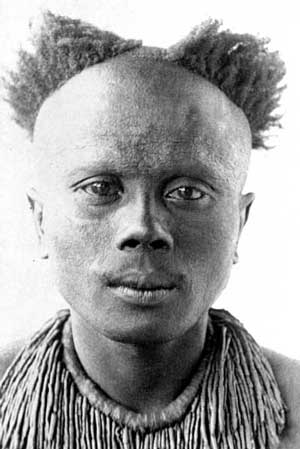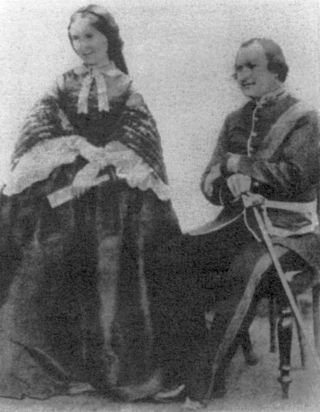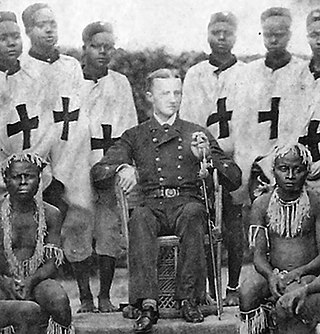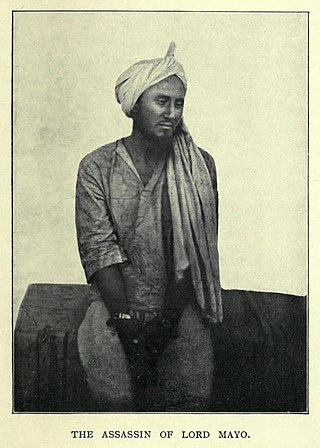
The Andaman Islands are an archipelago, made up of 200 islands, in the northeastern Indian Ocean about 130 km (81 mi) southwest off the coasts of Myanmar's Ayeyarwady Region. Together with the Nicobar Islands to their south, the Andamans serve as a maritime boundary between the Bay of Bengal to the west and the Andaman Sea to the east. Most of the islands are part of the Andaman and Nicobar Islands, a Union Territory of India, while the Coco Islands and Preparis Island are part of the Yangon Region of Myanmar.

The Andaman and Nicobar Islands is a union territory of India. It consists of 836 islands grouped into two island groups: the northern Andaman Islands and the southern Nicobar Islands, separated by a 150 km (93 mi) wide channel. Port Blair is the capital and largest city of the territory, located about 1,190 km (740 mi) from Chennai and 1,255 km (780 mi) from Kolkata in mainland India. The islands are sandwiched between the Bay of Bengal to the west and the Andaman Sea to the east with the northern-most point located 901 km (560 mi) from the mouth of Hooghly river. Indira Point at 6°45’10″N and 93°49’36″E at the southern tip of Great Nicobar is the southernmost point of India.

Penal transportation was the relocation of convicted criminals, or other persons regarded as undesirable, to a distant place, often a colony, for a specified term; later, specifically established penal colonies became their destination. While the prisoners may have been released once the sentences were served, they generally did not have the resources to return home.

Port Blair is the capital city of the Andaman and Nicobar Islands, a union territory of India in the Bay of Bengal. It is also the local administrative sub-division (tehsil) of the islands, the headquarters for the district of South Andaman, and the territory's only notified town.
Ritchie's Archipelago is a cluster of smaller islands which lie 20 km (12 mi) east of Great Andaman, the main island group of the Andaman Islands. The Islands belong to the South Andaman administrative district, part of the Indian union territory of Andaman and Nicobar Islands.

The Cellular Jail, also known as 'Kālā Pānī', was a British colonial prison in the Andaman and Nicobar Islands. The prison was used by the colonial government of India for the purpose of exiling criminals and political prisoners. Many notable independence activists, including Sardar Singh Artillery, Diwan Singh Kalepani, Yogendra Shukla, Batukeshwar Dutt, Shadan Chandra Chatterjee, Sohan Singh, Vinayak Savarkar, Hare Krishna Konar, Shiv Verma, Allama Fazl-e-Haq Khairabadi, and Sudhanshu Dasgupta were imprisoned here during the struggle for India's independence. Today, the complex serves as a national memorial monument.

The Great Andamanese are an indigenous people of the Great Andaman archipelago in the Andaman Islands. Historically, the Great Andamanese lived throughout the archipelago, and were divided into ten major tribes. Their distinct but closely related languages comprised the Great Andamanese languages, one of the two identified Andamanese language families.
Fazl-e-Haq Khairabadi was a Hanafi jurist, rationalist scholar, Maturidi theologian, philosopher and poet. He was an activist of the Indian independence movement and campaigned against British occupation. He issued an early religious edict in favour of doing military jihad against British colonialism during 1857 and inspired various others to participate in the 1857 rebellion. He wrote Taḥqīqulfatvá fī ibt̤āl al-t̤ug̲h̲vá in refutation of Ismail Dehlvi's Taqwiyat al-Imān and authored books such as al-S̲aurah al-Hindiyah.

Robert Christopher Tytler was a British soldier, naturalist and photographer. His second wife Harriet C. Tytler is well known for her work in photographing and documenting the monuments of Delhi and for her notes at the time of the 1857 revolt in India. Mt. Harriet in the Andamans is named after her. A species of bird, Tytler's leaf warbler, is named after him.

Ross Island, officially known as Netaji Subhash Chandra Bose Island, is an island of the Andaman Islands. It belongs to the South Andaman administrative district, Andaman and Nicobar Islands. The island is situated 3 km (2 mi) east from central Port Blair. The historic ruins are a tourist attraction.
Viper Island is an island of the Andaman Islands. It belongs to the South Andaman district of the Andaman and Nicobar Islands.

Maurice Vidal Portman was a British naval officer, who is best known for documenting and kidnapping some of the Andamanese tribes between 1879 and 1901 when he was posted as a superintendent of the Andaman Island Penal Colony.

Sher Ali Afridi was an Indian soldier of Pashtun background, convicted of murder and imprisoned at the penal colony of Port Blair, Andaman Islands. He is known for assassinating Lord Mayo, the Viceroy of India, on 8 February 1872. The British sources described him as a "fearless soldier and one who would have been selected for any service of danger".
Tourism in Andaman and Nicobar Islands relates to tourism in union territory of India, Andaman and Nicobar Islands. The Andamans are an archipelago of over 572 tropical islands, of which only 38 are inhabited. In 2004 Radhanagar beach at Havelock Island was bestowed with the title of "Asia’s Best Beach" and as the world's seventh most spectacular beach by Time Magazine.
The Battle of Aberdeen, on the Andaman Islands of India close to Port Blair, was an armed conflict that occurred on 14 May 1859 between the natives of the Andaman islands, the forces of the British colonial government in India, and to some extent the convicts of the Ross Island Penal Colony.

John Andaman or Jack Andaman was the name given to an Andaman native who was taken captive aboard a British navy ship near Interview Island on a survey of the Andaman Islands under Frederic J. Mouat. He was taken to Calcutta and returned to the place of his capture when ill health began to torment him. It has been suggested that Sir Arthur Conan Doyle described Tonga, an Andamanese native character, in his 1890 novel The Sign of Four based on Mouat's description of John Andaman.
Dudhnath Tiwari was an Indian convict from the Sepoy mutiny who was sent to the penal settlement in the Andamans and became famous for escaping and living with the Andamanese tribes for about a year. Accounts of life among the tribals, though coloured by his own prejudices and by possible embellishments, became famous in his time. During the time that he spent among the tribes, he came to learn of a tribal uprising being planned against the British at the penal settlement at which point he chose to return to the penal settlement and reveal the plans. The British penal settlement officers then prepared themselves for what was known as the Battle of Aberdeen in which the tribals were defeated. For his actions Tiwari was pardoned.
The Andaman and Nicobar Islands is an archipelago of 572 islands of which 37 are inhabited. It is a union territory of India.

Mount Manipur, formerly known as Mount Harriet, is the third highest peak in the Andaman and Nicobar Islands of India. The mountain houses the Mount Manipur Memorial, which commemorates the Manipuri freedom fighters of the Anglo-Manipur War and the Mount Manipur National Park (Mount Harriet National Park), which is best known for its rich biodiversity in the archipelago. On 17 October 2021, Mount Harriet was officially renamed as Mount Manipur by the Union Government of India, as a tribute to the freedom fighters of Manipur. This was initially announced by Amit Shah, the Union Home Minister of India, in a function in Port Blair, highlighting about the sacrifices of Yuvaraj Tikendrajit Singh, General Thangal, Meitei King Kulachandra Dhwaja Singh, the Maharajah of Manipur kingdom and other 22 freedom fighters of the Anglo-Manipur war of 1891.

Richard Southwell Bourke, 6th Earl of Mayo, the Viceroy and Governor-General of India, was assassinated on 8 February 1872 by Sher Ali Afridi, a disgruntled Indian soldier of Afghan Muslim background, who had been convicted of murder and condemned to penal servitude. The assassination occurred at the penal settlement of Port Blair, Andaman Islands, India. It was the first, and only, time a Governor-General of India was assassinated.














